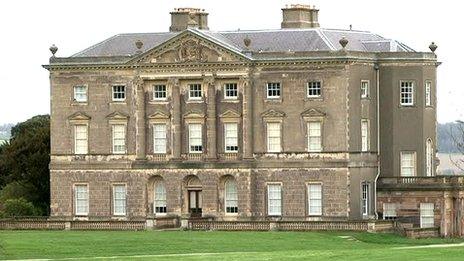Mystery of the vanishing County Down village Audley's Town
- Published

The residents of Audley's Town were tenants on the stately Castleward estate in County Down
Historians are trying to find out what happened to residents of a lost County Down village who set sail from Strangford 160 years ago.
They were from Audley's Town and lived in the shadow of the stately home of Castleward.
The villagers were put on a boat to America and one theory is, is that once evicted, their homes were torn down because their settlement was ruining the view of the then 'lord and lady' of the manor.
Up until the middle of the 19th century, about 250 people lived in Audley's Town. The 25 families were tenants on the Castleward estate.
Overgrown
Today, little is left of the village and the site is covered with woodland.
Local amateur historian Brian Fitzsimmons said some stone walls remain "but they are overgrown with ivy and it is very difficult to locate them".
"Most of the village has gone completely," he added.
National Trust archaeologist Malachy Conway said Audley's Castle is all that remains of a once-prosperous domain.
"In effect the village is obliterated," he said.
The demise of the Audley's Town residents came with the death of the then-lord of the land Viscount Bangor, who lived at Castleward.
His wife Harriet, or Lady Bangor, became widowed with six children.
Autocratic

Lady Bangor had a stern reputation and was known as 'The Evictor'
Mr Conway said she was a very autocratic lady and the scourge of the tenants on the estate.
"She was, I think, known as Lady Bangor 'The Evictor', so it gives you a little bit of a sense of her - she was a stern lady in many respects," he said.
Harriet remarried and went on to have a further four children with Major Savage-Nugent, who lived on the Nugent estate on the other side of Strangford Lough.
Mr Conway said he "treated the Castleward estate as his domain".
"There is some suggestion from the family themselves that not everything he did here was good," he said.
Woodland
The first ordinance map in 1834 shows a few hamlets, or clachans. By 1859, they had been replaced by 100 acres of woodland.
Mr Conway, who has studied the Castleward archives, said "tradition has it Major Andrew Savage-Nugent just did not like the inhabitants.
"They are referred to as being very poor and not the sort of sort you'd want as good neighbours on your property.
"So in many ways, it was seen as an act to try and remove a problem."
The other story is after Lady Bangor married Major Savage-Nugent, they decided to plant the woodland to make the two estates appear to blend into one another.
Brian Fitzsimmons said this plan seemed to work.
"The perspective of the house up there if you do look from the rear of it, it would appear the estates merge into on another because of the narrow distance of the lough at that particular point," he said.
Whatever the case, in 1852 the families were put on boat called the Rose, from Strangford to Boston.
Was this a kind act by the major to give the poor farm-dwellers a new start elsewhere?
Or were their homes blighting the view of the local gentry?
No record
The Rose had passengers like the Hinds, Smyths and O'Connors, but there is no record of them or the boat arriving in the US.
It could have sailed elsewhere, but was it ever destined for the US?
Was it lost at sea, or more sinisterly, was the human cargo thrown overboard when the vessel left the lough?
Mr Conway said it was a sad tale.
"There is an account from 1899 that a chap called Audley-Savage died unmarried in a little one-storey cottage on the hillside at Audley's Town and he in effect might be the last of the Audley male line," he said.
"This was a family that had arrived to settle after John de Courcy had arrived here and of course Anglo-Norman stock prospered
"What you can say about it is that particularly when the wards arrived here from the 1580s to 1590s onwards, it was the rise of one family and the decline in another."
Perhaps you are a descendant of the Audley's Town residents. If you are a relation please get in touch at claire.savage@bbc.co.uk